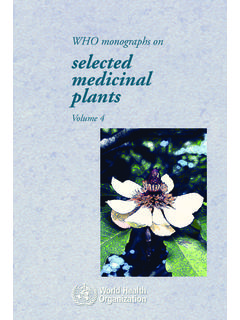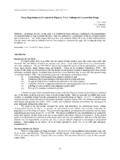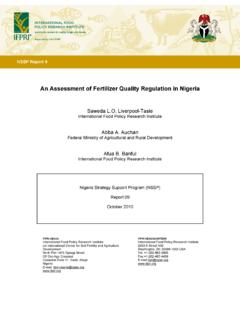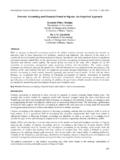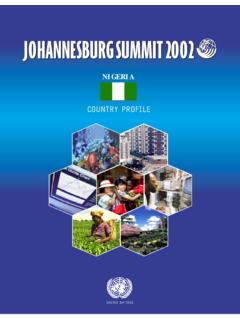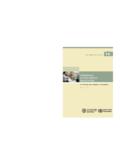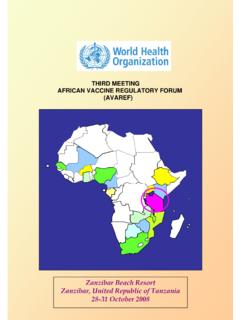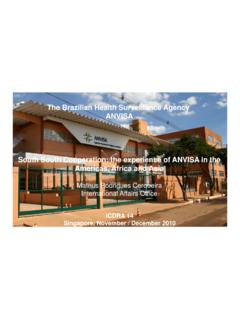Transcription of Pharmaceutical regulation: A twelve country study …
1 Pharmaceutical regulation: a twelve country study By: Paul G. Ashigbie, MPH candidate 2011, Boston University School of Public Health Supervisor: Dr. Richard Laing, Essential Medicines and Pharmaceutical Policy Department, WHO. [September 2010] (A Pharmaceutical Assessment Management and Policy (PAMP) practicum report) This document should be considered a draft report as not all of the data presented has been officially endorsed by national authorities Page 1 Table of Contents Abbreviations ..3 Executive Introduction ..11 Background ..13 The 2004 level I, 2003 level I and II and the 2007 level I surveys ..14 The 2002 Multi- country study on effective regulation ..16 The 2010 Pharmaceutical country profile pilot study ..17 Methods ..19 Results ..20 Profile of the study countries ..20 Regulatory framework and capacity of the study countries ..24 Marketing Authorization.
2 26 Regulatory inspection ..30 Import control ..31 Licensing ..32 Market control and quality control ..34 Medicines advertising and promotion ..35 Clinical trials ..37 Controlled Substances ..38 Pharmacovigilance ..39 Profile of the study countries ..44 Regulatory framework and Marketing authorization ..46 Regulatory inspection ..48 Import Licensing ..49 This document should be considered a draft report as not all of the data presented has been officially endorsed by national authorities Page 2 Market control and quality control ..49 Medicines advertising and promotion ..50 Clinical trials ..51 Controlled substances ..51 Pharmacovigilance ..52 Conclusions ..54 Recommendations ..56 References ..57 Annexes ..60 Annex 1 Websites of the MRAs ..60 Annex II URLS to the lists of registered products ..60 Annex III Link to Codes of Conducts for advertising and promotion.
3 61 Annex IV National Narcotic Laws review documents ..61 This document should be considered a draft report as not all of the data presented has been officially endorsed by national authorities Page 3 Abbreviations ADR Adverse Drug Reaction EMP Essential Medicines and Pharmaceutical Policy GCP Good Clinical Practice GDP Good Distribution Guidelines GMP Good Manufacturing guidelines GNI Gross National Income HAI Health Action International INN International Non-Proprietary Name MA Marketing Authorization MOH Ministry of Health MRA/DRA Medicines Regulatory Authority/Drugs Regulatory Agency NCE New Chemical Entity NMP National Medicines Policy SPC Summary Product Characteristics TPE Total Pharmaceutical Expenditure WHA World Health Assembly WHO World Health Organization This document should be considered a draft report as not all of the data presented has been officially endorsed by national authorities Page 4 Acknowledgements I am
4 Very grateful to the following individuals for all the assistance provided to me before, during and after my internship in World Health Organization (WHO), Geneva: Dr. Richard Laing, Coordinator of the Medicine Information and Evidence for Policy unit of the Essential Medicines and Pharmaceutical Policies (EMP) Department of the WHO, who directly supervised my internship and the preparation of this report from its beginning to the end. Dr Samvel Azatyan, who briefed me on the work of the EMP Department on Pharmaceutical regulatory assessments of some member countries of the WHO, and also reviewed and provided comments on this report. Dr Catherine Vialle-Valentin, a Senior Researcher, at the WHO Collaborating Center in Pharmaceutical Policy at the Harvard Medical School, who provided assistance and advice as to the analysis of the survey results for this report. Mr Enrico Cinnella of the EMP department reviewed and provided comments on this report.
5 Anita Korinsek Porta and Francine Meyroud of the EMP Department provided me with logistical support throughout my internship and in the preparation of this report. My colleagues among the 2010 EMP Departmental interns also reviewed this document and provided comments. I also benefitted from informational interviews with Dr Shanthi Pal of the Pharmacovigilance unit of the EMP, Dr Anthony Gould, Director of the WHO Medicines Prequalification project and Dr Willem Scholten of the Medicines Access and Rational Use program, and Prof. Kevin Outterson of Boston University School of Law on their various fields of expertise. The Boston University Pharmaceutical Assessment Management and Policy co-ordinating team, led by Prof. Lewis Kazis arranged for and co-ordinated my practicum with the WHO. Initiatives Incorporated provided funding for my trip to Geneva through the Jenny Huddart Scholarship which is managed by the Department of International Health of Boston, University School of Public Health.
6 Boston University Geneva Program, under the directorship of Dr Carla Rachman provided me with accommodation throughout my stay in Geneva. While all the people mentioned above contributed to my understanding of the issues described in this report, I remain the person responsible for the content of this report. This document should be considered a draft report as not all of the data presented has been officially endorsed by national authorities Page 5 Executive Summary This report presents the results and analyses of the regulatory section of a survey on the Pharmaceutical sector profiles of 12 countries (Argentina, Armenia, Austria, China, Jordan, Kenya, Maldives, Nigeria, Pakistan, Sri Lanka, Sudan and Suriname). The report was compiled by Paul Ashigbie a Master of Public Health student from Boston University for the World Health Organization (WHO). Dr Richard Laing, the leader of Medicine Information and Evidence for policy team of the Essentials Medicines and Pharmaceutical Policy (EMP) department of the WHO supervised the compilation.
7 The objective of the 2010 pilot study was to develop model Pharmaceutical country profiles. The pilot study precedes a bigger study that will involve all of WHO member states in 2011. Since the World Health Assembly (WHA) passed a resolution in 1975 calling on the WHO to be of greater direct assistance to member states in implementing national programs on Pharmaceutical regulation and the formulation of national drug policies, the WHO have undertaken a number of studies to assess the Pharmaceutical situation in its member states. These studies included the 1999 World Medicine Situation which was published in 2004, the 2003 levels I and II surveys, the 2007 level I survey, the 2002 ten country study on effective drug regulation, the Pharmaceutical regulatory assessments in some member states of the WHO, and the 2010 country profile pilot study of which the regulatory section is the focus of this report.
8 Method Data for this report was obtained by three main methods. The first method involved reviewing the answers provided by the countries on the 2010 Pharmaceutical country profile pilot study instrument. The second method involved reviewing the other supporting documents added to the survey results. For example, regulatory legislations, code of conducts, standard operating procedures (SOPs), adverse drug reaction (ADR) reports etc. submitted by the study countries, to confirm information already provided on the survey instrument or look for a new information altogether. The third method involved by browsing the websites of the Medicines Regulatory Authorities (MRAs) and other relevant websites for information. This document should be considered a draft report as not all of the data presented has been officially endorsed by national authorities Page 6 Findings The findings of the survey are summarised under the major regulatory functions and structure below: Profile of the study countries: The study countries were purposively selected to provide different country situations.
9 Therefore these countries varied widely in terms of socio economic indicators such as population density, gross national income (GNI) per capita, average life expectancy and under five mortality rate. The countries also differed in their Pharmaceutical sector indicators such as total Pharmaceutical expenditure, number of licensed pharmacies, number of licensed manufacturers and the number of registered products. The aim of selecting countries with different backgrounds was to obtain countries with different situations and not to obtain a sample representative of all member countries of the WHO. Regulatory framework and capacity: All of the 12 countries had legal provisions establishing the powers and responsibilities of their MRAs. However, only seven reported assessing their regulatory system within five years prior to the study . Regular assessment of regulatory systems is important in making the necessary adjustments to cope with the rapidly changing regulatory demands in the Pharmaceutical sector.
10 Nine of the 12 MRAs had their own websites. This is encouraging considering the fact that in the 2003 level I and II survey, less than half (51 out of 136) MRAs had their own websites. All of the MRAs received funds from the regular budget of their governments except in Kenya and Armenia. Seven MRAs (in Argentina, Armenia, Austria, Jordan, Kenya, Nigeria and Sudan) were partially funded from fees for services. Eight MRAs received funding from other sources. China was the only country that relied solely on government funding which could make the MRA of the country free from regulatory provider capture but not free from governmental control. Marketing authorization (MA): All of the twelve countries had legal provisions requiring marketing authorization of all Pharmaceutical products, legal provisions requiring for the registration of medicines by INN name or Brand name with INN name, as well as a publicly available criteria for assessing applications for marketing authorization.









